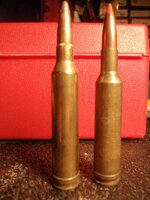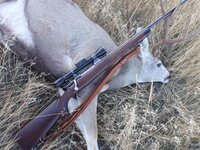Gold Supporter
- Messages
- 6,596
- Reactions
- 10,143
From the first volume of P.O. Ackley's Handbook for shooters and reloaders….
"Any rifle is a deer rifle; that is to say that deer have been killed with most all calibers from .22 R.F. up through the .25-20, .32-20, .38-40, .44-40 and so on.
However, in this day and age in speaking of a deer rifle, the rifle usually referred to is the .30-30, .32 Special, .300 Savage, .303 Savage and others.
Marlin now makes their handy Model 336 for the fine .35 Remington, which for my money, is one fo the best and most reliable game cartridges we have. It's 200 grain bullet is a good killer, even on elk.
While many elk are killed with the .30-30, it usually takes several hits to do the job; it doesn't compare with the .300 Savage.
The original load of the .303 Savage killed a host elk with its 195 grain bullet.
Then there is the .33 Winchester, almost a duplicate of the .35 Remington, but progress replaced it with the .348 Winchester.
The old Model '95 Winchester in .30-40 caliber is a real deer and elk gun. With its 220 grain bullet and mild recoil it is a real hunting rifle in any man's language; so is the old Krag in the same reliable .30-40 caliber.
But today, you must have a magnum!"
- Allyn H. Tedmon
It should be understood that this book originally came out in 1962 and I'm quoting a 3rd printing version from 1965.
Pretty interesting comments about some old and "obsolete" cartridges that were lauded when I was a young man.
Dean
"Any rifle is a deer rifle; that is to say that deer have been killed with most all calibers from .22 R.F. up through the .25-20, .32-20, .38-40, .44-40 and so on.
However, in this day and age in speaking of a deer rifle, the rifle usually referred to is the .30-30, .32 Special, .300 Savage, .303 Savage and others.
Marlin now makes their handy Model 336 for the fine .35 Remington, which for my money, is one fo the best and most reliable game cartridges we have. It's 200 grain bullet is a good killer, even on elk.
While many elk are killed with the .30-30, it usually takes several hits to do the job; it doesn't compare with the .300 Savage.
The original load of the .303 Savage killed a host elk with its 195 grain bullet.
Then there is the .33 Winchester, almost a duplicate of the .35 Remington, but progress replaced it with the .348 Winchester.
The old Model '95 Winchester in .30-40 caliber is a real deer and elk gun. With its 220 grain bullet and mild recoil it is a real hunting rifle in any man's language; so is the old Krag in the same reliable .30-40 caliber.
But today, you must have a magnum!"
- Allyn H. Tedmon
It should be understood that this book originally came out in 1962 and I'm quoting a 3rd printing version from 1965.
Pretty interesting comments about some old and "obsolete" cartridges that were lauded when I was a young man.
Dean
Last Edited:














